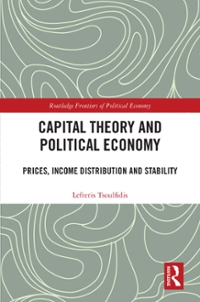Question
10. Read the article and answer the following questions i.According to the Solow growth model, what should developing countries focus to increase economic growth? ii.According
10. Read the article and answer the following questions i.According to the Solow growth model, what should developing countries focus to increase
economic growth? ii.According to the article, how do you define the technology?
iii.Using production function graphs, analyse the impact of improvement in technology in agriculture sector and its impact on the Nigeria's economic growth.
Nigerians typically have multiple sources of income. To have a single income source in Nigeria is to play yourself; never put all your eggs in one basket. Yet, it seems like the only Nigerian without multiple hustles is Nigeria itself. Oil accounts for about 70% of Nigeria's federal revenues and 90% of its foreign exchange earnings. No surprise then that the 2014 crash in oil prices triggered a recession, foreign exchange crisis, and higher government borrowing. Relying on commodities as your primary source of income (known as Dutch Disease) leaves the country vulnerable. Hence the growth of the diversification rhetoric. The question is, "What can Nigeria do to diversify its economy and earnings?"
The goal of policymakers should be to drive competitiveness, innovation, growth and productivity. According to the Solow growth model, arguably the most comprehensive theory of long-term economic growth, developing countries need to increase their long-term savings and investment rates. The theory predicts that an increase in the savings rate would lead to higher economic growth through investment and capital accumulation. Growth and development require access to substantial long-term savings pools that we may parlay into investments (new schools, waterways, broadband networks, etc.) that power stronger growth. A higher savings rate on the national level can be translated into investment in infrastructure and capital requirements for the growth of several industries. This may be low- hanging fruit for Nigeria as well since the country has a ridiculously low savings rate.
The story doesn't end with savings and capital accumulation, however. The Solow model makes a bold claim: the only way of sustainably increasing living standards in the long-term is through continual technological progress. It is impossible for an economy to grow forever solely by accumulating more capital. While savings and investment help with near-term growth, the key to sustainable long-term growth is continued technological progress.
With regards to economic growth and development, we need a more nuanced definition. We can define technology as the current state of knowledge on how to combine resources to produce desired products, to solve problems, fulfil needs, or satisfy wants; it includes technical methods, skills, processes, and techniques. Therefore, both the invention a new irrigation method and the creation of a more efficient credit process for farmers count as new technology.
Developing new technology would provide solutions to Nigeria's most pressing problems like abysmal health care, weak financial system, education and so on. Technology does this by improving infrastructure like power supply, creating a conducive business environment and improving educational systems, unlocking regional manufacturing and trade, and improving the physical and digital support we need to sustain growth in the long run. Technological progress increases productivity. For example, mobile banking and cash transfers have significantly impacted the ease of doing business in Nigeria. Introduction of mobile banking has reduced transaction time, reduced transaction cost, and increased the number of transactions conducted.
The agriculture sector shows us the potential scope for the impact of technology. Zenvus, a Nigerian precision farming startup measures and analyses soil data like temperature, nutrients, and vegetative health to help farmers apply the right fertiliser and optimally irrigate their farms. The process improves farm productivity and reduces input waste by using analytics to facilitate data-driven farming practices for small-scale farmers. SunCulture, which sells drip irrigation kits that use solar energy to pump water from any source, has made irrigation affordable. Each of these helps Nigeria in the drive for long-term food security.
Previous paragraphs touched on how technology has improved productivity in agriculture and financial services, but it applies everywhere. The key is to develop technologies that would solve uniquely Nigerian problems while producing goods and services for consumption and trade regardless of industry. These include solutions to health care issues, weak state-run education systems, broken infrastructure and low productivity in factories.
We need a strong focus on long-run growth. In addition to focusing on improving industries and making more money by selling more commodities, there should be a focus on innovating solutions to people's problems, ensuring income equality and improving the standard of living. Nigeria has the chance to lead the continent of Africa in the fourth industrial revolution.
Source: Merlin Uwalaka, Stears Business Limited (2017), 'the solution to long-run growth in Nigeriay, 19 February, at < https://www.stearsng.com/article/the-solution-to-long-run- growth-in-nigeria>, viewed 15 March 2018.
Step by Step Solution
There are 3 Steps involved in it
Step: 1

Get Instant Access to Expert-Tailored Solutions
See step-by-step solutions with expert insights and AI powered tools for academic success
Step: 2

Step: 3

Ace Your Homework with AI
Get the answers you need in no time with our AI-driven, step-by-step assistance
Get Started


